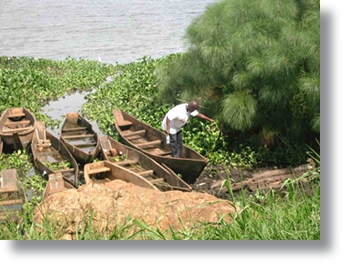Scientists Unleash Weevils on Water Hyacinth

 |
| Aquatic weed is an environmental hazard Photo courtesy |
The two biological agents, which are weevils, feed on only water hyacinth and have proved to be effective control agents of the water weed, according to Obinna Ajouno, a scientist with the International Institute of Tropical Agriculture.
The released weevils were mass produced by the Department of Agriculture in Porto-Novo using start-up colony supplied by the International Institute of Tropical Agriculture that also provided technical assistance.
Ajouno says that the biocontrol exercise is the first of its kind by researchers in the Mono River to control the aquatic weed.
“Previous efforts by IITA and partners using biocontrol agents against water hyacinth yielded success on the Oueme River eight years ago. So we are confident this approach will produce results,” he explains.
Participants in the release included the Department of Agriculture, the National Coordination Unit of the Benin Economic Community of West African States’ Water Weeds Project, the local communities and IITA.
The project is part of the ongoing African Development Bank (AfDB) funded ECOWAS integrated project for the control of aquatic weeds involving physical removal, utilisation, and biological control methods.
Alien to Africa, water hyacinth (Eichhornia crassipes) often grows as floating plants or mats, as islands of plants floating freely on the water, or mixed with other vegetation on river banks. In nutrient-rich waters, such as in polluted ponds or lakes, it can grow so quickly that the surface covered by the mats doubles every four to seven days.
The aquatic weed poses serious socioeconomic and environmental problems to millions of people in riparian communities and is, therefore, an added constraint to development. For instance, more than 12000 hectares of this weed infest Lake Victoria, affecting the livelihood of many of the more than 40 million people in Kenya, Tanzania, and Uganda. The weed obstructs electricity generation, irrigation, navigation, and fishing; increases water loss resulting from evapotranspiration; and facilitates proliferation of such diseases as bilharzia.
In Sudan alone, a partial evaluation of socioeconomic costs of water hyacinth, estimates that annual water loss from evapotranspiration over 300 km2 of canal would be enough to irrigate more than 400 ha. Effects on navigation in the Nile include 50 per cent higher running and maintenance costs and 30 per cent more use of fuel.
The cost of chemical control alone over 15 years would have been in excess of 19 million United States dollars, according to the International Development Research Centre (IDRC). Until 2000, the Mono River which borders Togo was free of water hyacinth. Researchers are of the view that the weed might have been infested through human activities. Ajouno says the impact of these biological agents—(weevils) — in the Mono River system in the years ahead will be monitored by regular field visits involving the collaborating institutions.
Courtesy, IITA.
